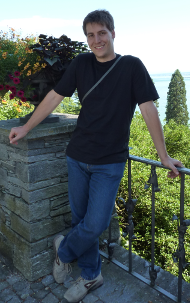 |
Institute for Atmospheric Physics
Johannes Gutenberg University Mainz
Becherweg 21
55099 Mainz Fon: +49-(0)6131-39-24152 Email: Manuel Baumgartner
|
Ph.D. student in the group Theoretical Cloud Physics, headed by Prof. Peter Spichtinger.
Numerical modeling of the Wegener-Bergeron-Findeisen process within the Project HD(CP)2 (High definition clouds and precipitation for advancing climate prediction)
We consider the growth or evaporation of cloud particles due to diffusion of water vapor in a mixed-phase cloud, i.e. a cloud containing liquid water droplets and ice particles. Depending on the
current humidity there are three different possibilities: the droplets and ice particles both grow, both evaporate or the droplets evaporate while the ice particles grow. The last scenario is known as
"Wegener-Bergeron-Findeisen process". The local spatial distribution of water vapor around a cloud particle dictates if it will grow or evaporate. This local distribution of water vapor is particularly influenced by the presence of other near cloud particles. For example, in an environment where both species of cloud particles should evaporate, an ice particle might be surrounded by evaporating
droplets. These droplets enrich their neighborhood with humidity. As a result, this particular ice particle can grow. We simulate local interactions of cloud particles with a direct numerical simulation,
where the coupled system of diffusion equations for water vapor and heat are solved with a finite element method on a discrete numerical grid. In order to avoid the explicit adaptation of the grid to the
curved cloud particles, we employ the so-called extended finite element method. The extended finite element method consists in enriching the standard finite element space with suitable functions to
capture the local behaviour of the solution.
Since it is not feasible to simulate a whole cloud with such a detailed particle model, we develop a so-called "bulk model". In a bulk model we look at the whole cloud in a statistical sense which is
a widely used approach in cloud modeling. In common models, the direct interaction of the cloud particles by diffusion is neglected; they can interact only via a distant reservoir representing the environment
conditions. Our bulk approach retains the interaction of ice particles with surrounding droplets.
- SS 2013: Exercise instructor for "Anwendung von Modellen" (Prof. Spichtinger)
- WS 2013/2014: Exercise instructor for "Atmosphärische Thermodynamik" (Prof. Spichtinger)
- SS 2014: Exercise instructor for "Anwendung von Modellen" (Prof. Spichtinger)
- WS 2014/2015: Exercise instructor for "Modellbildung" (Prof. Spichtinger)